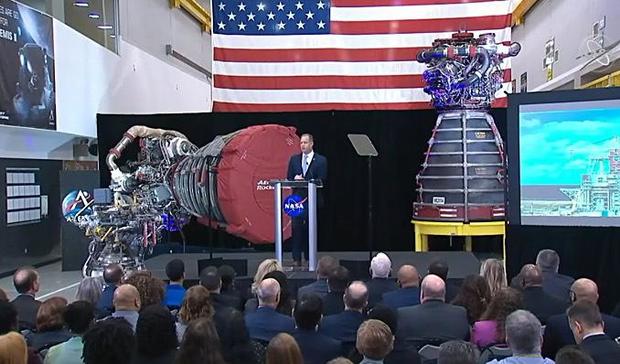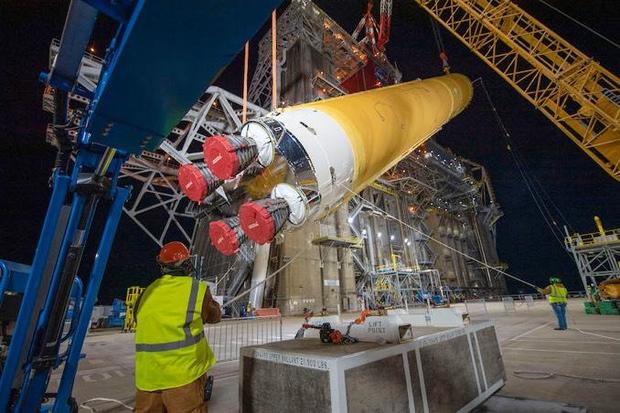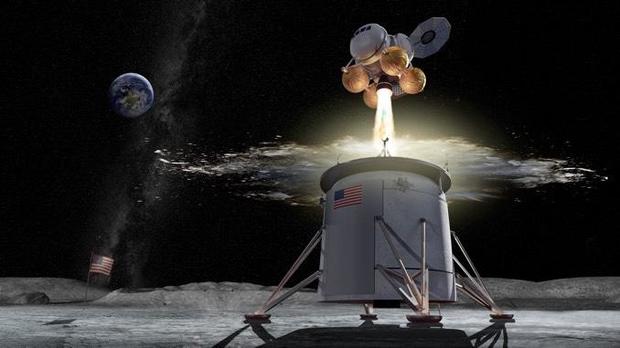Trump requests sharp funding boost for NASA's Artemis moon program
The Trump administration is requesting $25.2 billion for NASA in fiscal 2021, a 12% increase that includes $3.3 billion to kickstart development of a human-rated lander for the Artemis moon program. Nearly half of the budget request, $12.3 billion, is devoted to new and ongoing projects focused on the return to the moon and eventual flights to Mars.
"This is a 21st century budget worthy of 21st century space exploration and one of the strongest budgets in NASA history," said NASA Administrator Jim Bridenstine. "If the president's support for NASA wasn't clear before, it should be obvious now."
NASA documents indicate it will cost about $35 billion to fund the Artemis moon program, as currently envisioned, through the first landing of a man and woman on the lunar surface in 2024. To make that happen, the budget request says NASA will need $25.2 billion in 2021, $27.2 billion in fiscal 2022, $28.6 billion in 2023, $28.1 billion in 2024 and $26.3 billion in 2025.
Whether a generally supportive Congress will go along with that level of spending in an era of bipartisan conflict and the administration's call for major cuts in a variety of other programs remains to be seen. But the administration is bullish.
"America is leading the world in a new era of space exploration that will send the first woman and the next man to the moon in 2024 and build a sustainable presence on the lunar surface," the White House said in a budget summary.
"Through learning to live and work on the moon, the United States and our international and commercial partners will develop the experience, technology and systems that we will need to eventually send humans to Mars. These efforts will continue America's standing as the world leader in space exploration."
The budget proposal reflects a significant increase over the $22.6 billion approved by Congress for fiscal 2020 and "provides sustained robust funding from FY 2021 to FY 2025 for exploration through the date of the next lunar landing and beyond," according to the White House summary.
"The President's budget invests more than $25 billion in NASA to fortify our innovative human space exploration program while maintaining strong support for our agency's full suite of science, aeronautics, and technology work," Bridenstine said in a statement.
"The budget proposed represents a 12 percent increase and makes this one of the strongest budgets in NASA history. The reinforced support from the president comes at a critical time as we lay the foundations for landing the first woman and the next man on the south pole of the moon by 2024. This budget keeps us firmly on that path.""
The Trump administration ordered NASA to return to the moon in a directive signed in December 2017 and last year, Vice President Mike Pence, chairman of the National Space Council, set 2024 as the landing target. NASA had been planning for a return to the moon in the 2028 timeframe.
The agency says the Trump administration's 2021 funding request supports the 2024 goal, although details about the Artemis architecture are open for discussion, including whether the initial flights will require the use of a small lunar space station known as Gateway.
"This budget keeps us on the road to land the first woman and the next man on the moon by 2024 and, with support of the Gateway, helps prepare us for exploration of Mars and beyond," NASA said in an internal overview. "The President has directed over $3 billion dollars toward development of a human lunar landing system, the first time we have had direct funding for a human lander since Apollo."
The budget provides $4 billion to fund deep space exploration, including $2.26 billion for ongoing development of the Boeing-managed Space Launch System — SLS —heavy-lift rocket, $1.4 billion for the Lockheed Martin Orion capsule that will carry astronauts to and from the moon and $385 million for the ground systems needed to support the lunar architecture.
The gargantuan first stage of the first SLS rocket is currently at the Stennis Space Center in Mississippi being readied for a critical, full-duration test firing of its four shuttle-era main engines. If all goes well, an SLS and an Orion capsule will be launched on an unpiloted test flight around the moon next year.
If that mission, known as Artemis 1, goes well, NASA plans to launch an SLS-Orion piloted test flight, Artemis 2, in the 2023 timeframe, followed by the first human landing in the Artemis 3 mission sometime in 2024.
The $35 billion NASA says the Artemis program will cost through the Artemis 3 mission includes the $3.3 billion earmarked for lunar lander development as well as the $4 billion requested for Orion, the SLS and ground systems. Another $175 million is devoted to lunar surface spacesuits, $212 million for initial designs for a surface habitat and moon rovers and $254 million is devoted to commercial services to send science and exploration instruments to the lunar surface.
The Gateway, funded at $739.3 million in the 2021 budget, is a somewhat controversial element in the Artemis program. The initial architecture called for assembling the outpost robotically in a high lunar orbit reachable by the Orion spacecraft. The commercially-developed moon lander, also assembled there, would be waiting to carry the Artemis 3 crew down to the surface and back.
NASA is evaluating commercial lander proposals, including one led by Blue Origin that would utilize Gateway and one from Boeing that would use a single SLS rocket to propel both the Orion capsule and the lander directly into a lower lunar orbit for landing.
"NASA wants to explore all options to land the crew on the moon and remains open to approaches that do not require docking to the Gateway," according to the internal agency overview. "While the Gateway is not a requirement for the human landing system in 2024 and 2025 landings, the Gateway will be required for the sustained missions starting in 2026."
NASA's current plan is to launch the core elements of the Gateway — a power and propulsion module and a habitation and logistics element known as HALO — aboard commercial rockets before 2024.
The long-term, or "horizon," goal of NASA's human space program remains piloted flights to Mars. NASA says the Artemis program will "accelerate" planning for eventual flights to orbit or land on Mars in the 2030s by "developing technologies and strategies that can be perfected on the moon before going to Mars."
That includes solar electric propulsion and critical life support systems, along with the Gateway, which "could serve as the departure point in lunar orbit for a proposed Mars deep space transport," NASA said. "It will help demonstrate autonomous spacecraft systems management and long-term reliability of similar systems needed in a deep space environment."
The budget request also includes $529 million for robotic exploration of Mars, including a planned mission to returned cached soil and rock samples to Earth for laboratory analysis.
Beyond Artemis, the fiscal 2021 budget request includes $1.4 billion for the International Space Station. which NASA plans to operate through "at least" 2024, and $1.88 billion for the agency's commercial crew and cargo programs.
Space science would receive $6.3 billion, including $2.66 billion for planetary science, $831 million for astrophysics, $1.77 billion for Earth science and $414.7 million for final work to ready the $9.7 billion James Webb Space Telescope for launch in March 2021. The planetary science request covers the initial Mars sample return work and continues initial development of a probe to study Jupiter's icy moon Europa.
But the request would eliminate funding for the SOFIA Airborne Observatory, a 747 jet equipped with a powerful infrared telescope, and zero out funding for the WFIRST project, a Hubble-class space telescope NASA has tried to kill before. Two "lower priority" Earth science missions also would be canceled.
"While SOFIA has produced valuable science, it costs more than $80 million per year and has not proven to be as scientifically productive as other missions," NASA said in its budget review. "The SOFIA mission is proposed for termination due to higher priorities within NASA."







